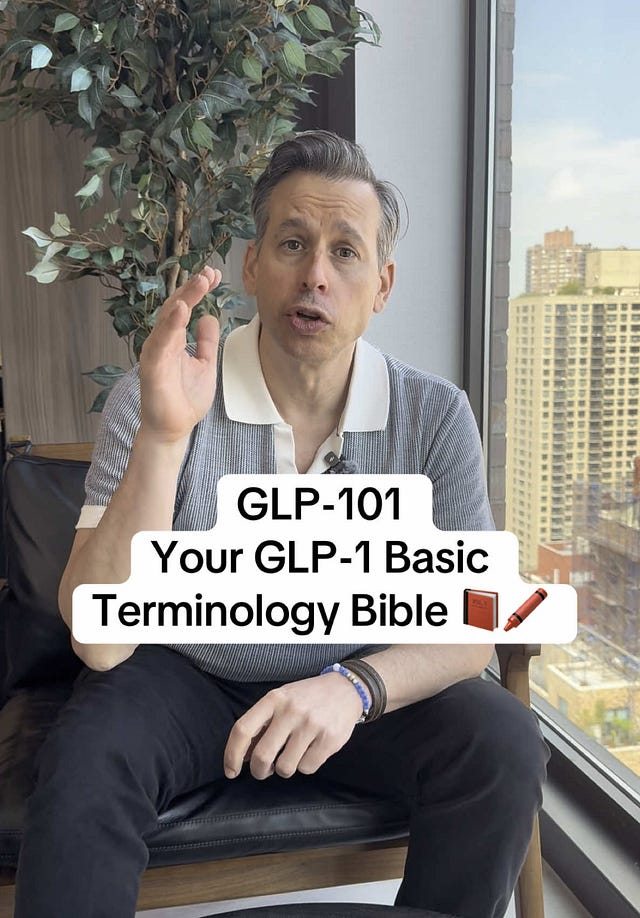After I published Microdosing GLP-1 is Not an Obesity Treatment, my inbox filled with confusion. Not about whether microdosing was effective, but about what it even meant. Some people thought it was anything under 5 milligrams of Zepbound. Others said it meant splitting up your dose. Some folks just used it to describe taking a little something to take the edge off.
The article wasn’t just about dosages. It was about how chaotic this conversation has become without a common language. If we can’t even agree on what words mean, how are we supposed to help people make good decisions?
So when Dr. Daniel Rosen, a bariatric surgeon and friend of On The Pen, posted a video that laid out clear definitions for the most used GLP-1 terms, I knew I had to spotlight it. It’s the structure this space has been missing. It’s GLP-1 101. And it’s a gift to the entire community.
💡 Now more than every, OTP can use your support. If our content is helpful, consider ogoing paid. It lets me keep doing this for the people who need it most.
👉 You can do that right here with just a couple clicks.
Start Here: Dr. Rosen’s Video
📹 TikTok: “GLP-1 101” by Dr. Daniel Rosen

 Tiktok failed to load.
Tiktok failed to load.Enable 3rd party cookies or use another browser
Watch Dr. Rosen’s On The Pen Live Episodes!
Glossary of GLP-1 Terms
(Based on the definitions provided by OTP friend, Dr. Daniel Rosen)
Regular responder
Loses 1 to 3 pounds per week on a GLP-1 medication.
Slow responder
Loses between one half and one pound per week.
Non responder
Loses less than one half pound per week.
Super responder
Loses more than 3 pounds per week.
Microdosing
Taking less than the lowest available commercial dose each week.
This means under 2.5 milligrams of tirzepatide or under 0.25 milligrams of semaglutide.
Splitting doses
Taking your total weekly dose in smaller injections throughout the week.
For example, taking 1 milligram three times a week equals 3 milligrams. That is not microdosing. That is dose splitting.
Top off dose or Turbo boost
Adding a smaller shot midway through the week when the effects of your main dose start wearing off. The goal is to keep hunger at bay until your next regular dose.
Supratherapeutic dosing
Using more than the highest available commercial dose in a given week.
Often used by people who have stalled at the max standard dose.
Adjuncts
Prescription medications added to a GLP-1 for extra weight loss support.
These can include phentermine, topiramate, bupropion, naltrexone, or metformin.
Stacking
Adding non prescription peptides alongside your GLP-1.
Examples include Tesamorelin, CJC with DAC, Sermorelin, or AOD.
Cushion
Losing an additional 3 to 5 pounds beyond your goal weight to protect against minor regain. This gives you breathing room and helps maintain long term success.
Weaning down
Gradually reducing your dosage instead of stopping suddenly.
For commercial meds, this usually follows a stepdown schedule. For compound meds, it may mean lowering by small increments over time.
Stretching the interval
Extending the time between your injections.
Instead of every 7 days, you might try every 10 days or every 2 weeks as a way to reduce medication use while maintaining your results.
The terms are simple, but the impact is big. They give shape to what so many of us are already doing, or thinking about doing. They create a shared framework so that when someone says "I’m microdosing" or "I hit a stall," we know exactly what they mean.
And for a space this big, with this many people navigating care in the dark, shared language is one of the most powerful tools we can have. Curious what you would add?
Stay tuned to On The Pen for more original reporting, expert conversations, and patient centered coverage of the GLP-1 world. And if you’re new here, welcome. This community is for you.





Much needed information! Thank you! 😊
Stretching the interval is what I'm doing to help the sting of paying out of pocket!